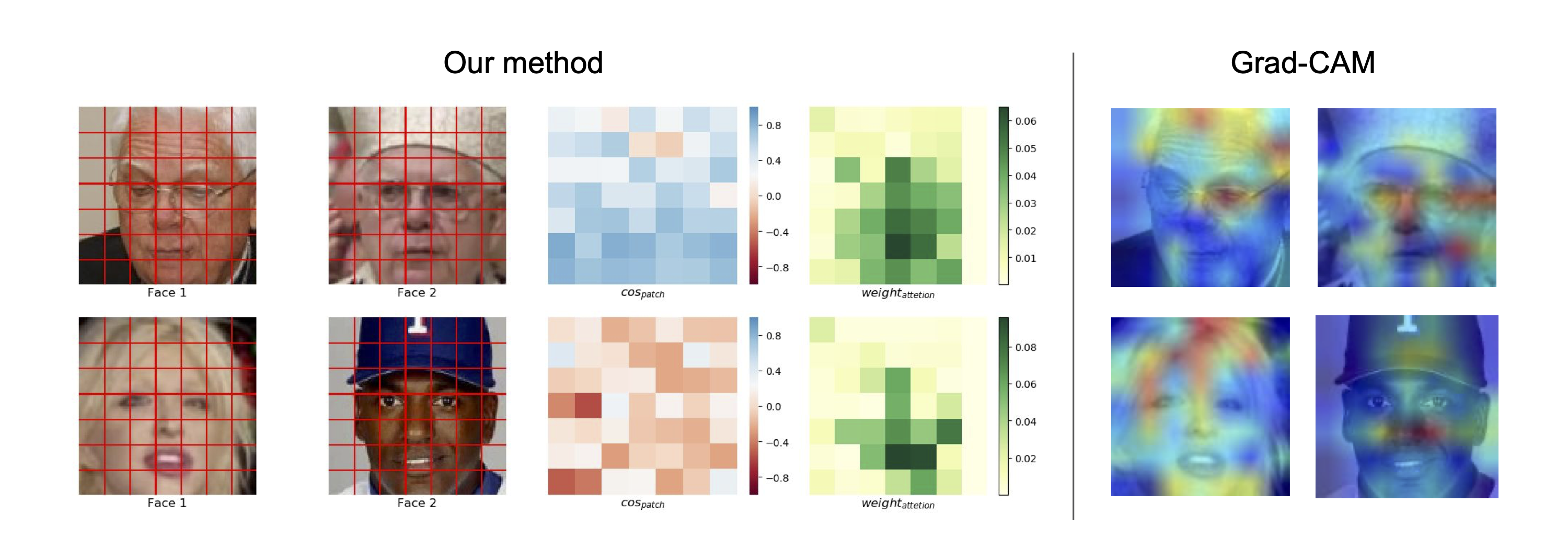Official Pytorch implementation of "xCos: An Explainable Cosine Metric for Face Verification Task (ACM TOMM 2021)" arXiv
In "xCos: An Explainable Cosine Metric for Face Verification Task", we propose a novel similarity metric, called explainable cosine xCos, that comes with a learnable module that can be plugged into most of the verification models to provide meaningful explanations.
 State-of-the-art face verification models extract deep features of a pair of face images and compute the cosine similarity or the L2-distance of the paired features. Two images are said to be from the same person if the similarity is larger than a threshold value. However, with this standard procedure, we can hardly interpret these high dimensional features with our knowledge.
State-of-the-art face verification models extract deep features of a pair of face images and compute the cosine similarity or the L2-distance of the paired features. Two images are said to be from the same person if the similarity is larger than a threshold value. However, with this standard procedure, we can hardly interpret these high dimensional features with our knowledge.
 Although there are some previous works attempting to visualize the results on the input images with saliency map, these saliency map based visualizations are mostly used for the localization of objects in a single image rather the similarity of two faces. Therefore, our framework provides a new verification branch to calculate similarity maps and discriminative location maps based on the features extracted from two faces. This way, we can strike a balance between verification accuracy and visual interpretability.
Although there are some previous works attempting to visualize the results on the input images with saliency map, these saliency map based visualizations are mostly used for the localization of objects in a single image rather the similarity of two faces. Therefore, our framework provides a new verification branch to calculate similarity maps and discriminative location maps based on the features extracted from two faces. This way, we can strike a balance between verification accuracy and visual interpretability.

git clone git@github.com:ntubiolin/xcos.git
cd xcos
conda env create -f environment_xcos_template.yml
source activate xcos_template
The training dataset should be a folder structured like torchvision.datasets.ImageFolder:
root/person_1/face_1.jpeg
root/person_1/face_2.png
root/person_2/face_1.jpg
root/person_n/face_1.png
root/person_n/face_2.png
root/person_n/face_m.png
The validation/ testing dataset we use are stored in a binary format. For customized validation/ testing dataset, you can write a customized dataset which read your own dataset and return the same format as the __getitem__ method in .src.data_loader.face_datasets.InsightFaceBinaryImg, and then wrap the dataset with a new dataloader like the one in .src.data_loader.data_loaders.FaceBinDataLoader.
If you have no idea what the datasets you can use, insightface would be a good start.
Please refer to the pytorch-golden-template for detailed config options.
Please execute cd src/ first before executing the following codes.
Train the model from scratch:
python main.py -tc configs/xcos_train_config.json
The pretrained weights can be accessed at Google Drive. You can download it and place it under ../pretrained_model/xcos/.
python main.py -tc configs/xcos_testing.json --mode test -p ../pretrained_model/xcos/20200217_accu_9931_Arcface.pth
First, download and unzip mtcnn_pytorch under src/. The mtcnn_pytorch module is used in the src/visualize_xcos_one_example.ipynb.
Second, please refer to src/visualize_xcos_one_example.ipynb. To get the visualization of xCos, you can replace the img1 and img2 image paths with the paths of the photos of your interest.
This repository is limited to research purpose. For any commercial usage, please contact us.
Yu-sheng Lin ntubiolin biolin@cmlab.csie.ntu.edu.tw
Zhe-Yu Liu Nash2325138 zhe2325138@cmlab.csie.ntu.edu.tw
Yu-An Chen
Yu-Siang Wang
Ya-Liang Chang (Allen) amjltc295 yaliangchang@cmlab.csie.ntu.edu.tw
Winston H. Hsu whsu@ntu.edu.tw
Please cite our papers if you use this repo in your research:
@article{10.1145/3469288,
author = {Lin, Yu-Sheng and Liu, Zhe-Yu and Chen, Yu-An and Wang, Yu-Siang and Chang, Ya-Liang and Hsu, Winston H.},
title = {XCos: An Explainable Cosine Metric for Face Verification Task},
year = {2021},
issue_date = {October 2021},
publisher = {Association for Computing Machinery},
address = {New York, NY, USA},
volume = {17},
number = {3s},
issn = {1551-6857},
url = {https://doi.org/10.1145/3469288},
doi = {10.1145/3469288},
abstract = {We study the XAI (explainable AI) on the face recognition task, particularly the face verification. Face verification has become a crucial task in recent days and it has been deployed to plenty of applications, such as access control, surveillance, and automatic personal log-on for mobile devices. With the increasing amount of data, deep convolutional neural networks can achieve very high accuracy for the face verification task. Beyond exceptional performances, deep face verification models need more interpretability so that we can trust the results they generate. In this article, we propose a novel similarity metric, called explainable cosine (xCos), that comes with a learnable module that can be plugged into most of the verification models to provide meaningful explanations. With the help of xCos, we can see which parts of the two input faces are similar, where the model pays its attention to, and how the local similarities are weighted to form the output xCos score. We demonstrate the effectiveness of our proposed method on LFW and various competitive benchmarks, not only resulting in providing novel and desirable model interpretability for face verification but also ensuring the accuracy as plugging into existing face recognition models.},
journal = {ACM Trans. Multimedia Comput. Commun. Appl.},
month = {nov},
articleno = {112},
numpages = {16},
keywords = {xCos, face recognition, XAI, explainable artificial intelligence, face verification, explainable AI}
}
This work was supported in part by the Ministry of Science and Technology, Taiwan, under Grant MOST 109-2634-F-002-032. We benefit from the NVIDIA grants and the DGX-1 AI Supercomputer and are also grateful to the National Center for High-performance Computing.
